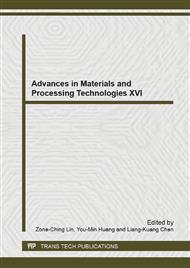[1]
B. Yesilata, P. Turgut, A simple dynamic measurement technique for comparing thermal insulation performances of anisotropic building materials, Energy and Buildings 39 (2007) 1027–1034.
DOI: 10.1016/j.enbuild.2006.11.007
Google Scholar
[2]
K. Bessri, F. Montembault, E. Bayraktar, C. Bathias, Understanding of Mechanical Behaviour and Damage Mechanism in Elastomers Using X-Ray Computed Tomography at Several Scales, International Journal of Tomography and Statistics IJTS 14 (2010).
Google Scholar
[3]
E. Bayraktar, S. Antholovich, C. Bathias, Multiscale observation of fatigue behviour of elastomeric matrix and metal matrix composites by x-ray tomography, IJF International Journal of Fatigue 28 (2006) 1322-1333.
DOI: 10.1016/j.ijfatigue.2006.02.030
Google Scholar
[4]
E. Bayraktar, N. Isac, K. Bessri, C. Bathias, Damage mechanisms in natural (NR) and synthetic rubber (SBR): nucleation, growth and instability of the cavitations, IJFSM International Journal of Fatigue and Fracture of the Structural Materials 31 1 (2008).
DOI: 10.1111/j.1460-2695.2007.01213.x
Google Scholar
[5]
R. Luong, N. Isac, E. Bayraktar, Damage initiation mechanisms of rubber, JAMME journal of archives of materials science and engineering, 28 1 (2007) 19-26.
Google Scholar
[6]
W. C. Oliver, G. M. Pharr, An improved technique for determining hardness and elastic modulus using load and displacement sensing indentation experiments, Journal of Materials Research 7 (1992) 1564-1583.
DOI: 10.1557/jmr.1992.1564
Google Scholar
[7]
D. Zaimova, E. Bayraktar, D. Katundi, N. Dishovsky, Elastomeric matrix composites: effect of processing conditions on the physical, mechanical and viscoelastic properties, JAMME Journal of Achievements in Materials and Manufacturing Engineering 50-2 (2012).
Google Scholar
[8]
D. Zaimova, E. Bayraktar, N. Dishovsky, State of cure evaluation by different experimental methods in thick rubber parts, JAMME, Journal of Achievements in Materials and Manufacturing Engineering, 44 2 (2011) 161-167.
Google Scholar
[9]
J. Hay, Introduction to Instrumented Indentation Testing, Experimental Techniques, SEM: Society for Experimental Mechanics, (2009) 66-71.
Google Scholar
[10]
D. S. Botelho, E. Bayraktar, Experimental and Numerical Study of Damage Initiation Mechanism in Elastomeric composites-Double Cantilever Beam specimens-DCB, JAMME Journal of Achievement in Materials and Manufacturing Engineering 36 1 (2009).
Google Scholar
[11]
D. Zaimova, E. Bayraktar, D. Katundi, N. Dishovsky, a preliminary study of filler particles and epoxy resin-reinforced elastomeric based composites , IMSP2012 – The 14th International Materials Symposium - Denizli – Turkey (2012).
Google Scholar
[12]
A. T Catherine, J. V.V. Krystyn, Contact Creep Compliance of viscoelastic materials via nanoindentation, Journal of Materials Research 21 6 (2006).
Google Scholar
[13]
D. S. Botelho, N. Isac, E. Bayraktar, Modelling of damage initiation mechanism in rubber sheet composites under the static loading, JAMME International journal of achievement in materials and manufacturing engineering 22 2 (2007) 55-59.
Google Scholar
[14]
L. G. Yan Tolle, R. G. Craig, Viscoelastic properties of elastomeric impression materials: polysulphide, silicone and polyether rubbers, Journal of Oral Rehabilitation 5 (1978) 121-128.
DOI: 10.1111/j.1365-2842.1978.tb01204.x
Google Scholar
[15]
Fischer-Cripps A.C., Nanoindentation 3rd edition, Springer-Verlag, Chapter 2, pp.29-30, New York, 2011, pp.29-30.
Google Scholar
[16]
T. F. Juliano, M. R. Vanlandingham, C. A. Tweedie, K. J. Van Vliet, Multiscale Creep Compliance of Epoxy Networks at Elevated Temperature, Experimental mechanics; SEM: Society for Experimental Mechanics, . 47 (2007) 99-105.
DOI: 10.1007/s11340-006-8276-5
Google Scholar
[17]
N. Ouali, A.C. Oppici, Elastomer toughened epoxy based composites, AMPT-Wollongong-Sydney, NSW-Australia (2012).
Google Scholar


